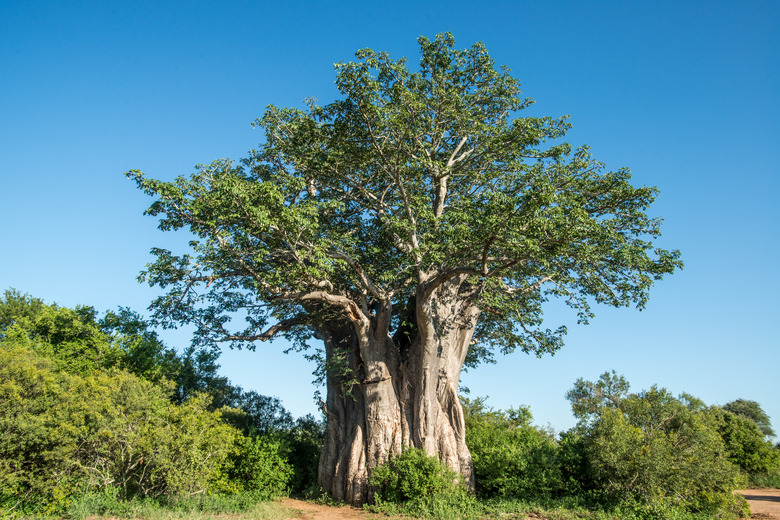Tropical Dry Forest Plants
Tropical dry forests are a diverse biome found in Central and South America, Asia, Africa and Australia. Tropical dry forest climates experience warm to hot temperatures throughout the year. Although they can receive significant rainfall, which prevents the ecosystem from becoming desert, they regularly experience periods of up to several months without rainfall.
Therefore, many tropical dry forest plants have evolved methods of conserving water to cope during these dry periods. These adaptations include shedding leaves during the dry season, storing water in their body tissue and developing protective spines, thorns and other structures.
Columnar Cacti
Columnar Cacti
Columnar (ceroid) cacti are succulent plants that store water and nutrient reserves in their fleshy tissue during dry seasons. They are iconic desert plants, with the saguaro cactus (Carnegiea gigantea) being particularly emblematic of the American Southwest. They have evolved without leaves to reduce water loss. Photosynthesis takes place in the stem, with chlorophyll giving them their green color.
Columnar cacti produce an extensive, shallow network of roots to absorb large quantities of water during rainfall events. They rapidly bloom after rain, attracting pollinating insects that fertilize the flowers, instigating rapid seed development. Columnar cacti may live for hundreds of years.
Acacia Trees
Acacia Trees
Acacias (Acacia spp.) consist of several different types of trees, shrubs and bushes commonly found in Africa and Australasia. Many acacia species obtain water through long tap roots, which reach up to 60 feet underground to access groundwater. They have small leaves which often have a thick waxy layer called a cuticle, which helps reduce evaporation.
Acacias also protect themselves with thorns, spines and unpleasant-tasting compounds to reduce grazing pressure, which can cause significant water loss. In some species, the spines are hollow and provide a home for a species of ant, which will attack other insects and grazing animals when they attempt to eat the tree.
Ceiba Trees
Ceiba Trees
Like many tropical dry forest trees, the Ceiba tree (Ceiba trichastandra) is deciduous, which means it sheds its leaves at the start of the dry season. This reduces water loss through the respiratory pores (stoma) on the leaf surface. Ceiba trees have green bark that continues to photosynthesize, allowing them to reduce water loss while maintaining energy production. When young, Ceiba trees produce spines to deter herbivores.
Baobab Trees
Baobab Trees
Baobab trees (Adansonia spp.) are found in Madagascar, mainland Africa and Australia. They can live for up to 1,000 years and are famed for their large round trunks, which can grow to 30 feet in diameter. They can store large quantities of water in the trunk for use during dry periods. They also produce small leaves following rainfall and then shed them when conditions become drier to conserve water.
Agave Plants
Agave Plants
Agave plants (Agave spp.) are found in Central and South America, and they store water and nutrients similar to the way cacti do. They also use an alternative method of respiration which requires less water than other plants. It can take many years for agave plants to accumulate enough water and nutrients to allow flowering, which gives them their common name of 'century plant.'
Epiphytes, Mosses and Lichens
Epiphytes, Mosses and Lichens
Epiphytes are plants that grow upon other plants, most commonly along tree branches and limbs in the canopy. Because they obtain moisture from the air, not the soil, they are particularly affected by a lack of rainfall. Strategies epiphytes use to conserve water include storing it in their stems and body tissue, growing hairs around stoma to reduce evaporation and storing water in bowl-shaped leaf structures.
Mosses and lichen also live on other plants, as well as rocks and soil. Due to their simple structure, they are unable to store large quantities of water. During dry periods, mosses and lichens will dry out and desiccate, giving the appearance of being dead. However, when rains or other moisture returns, they will regain their color and recommence photosynthesis and growth.
References
- Tropical Dry Forest Biome: Plants of the Tropical Dry Forest
- Springer Open: Tropical dry forest dynamics in the context of climate change: syntheses of drivers, gaps, and management perspectives
- Ceiba Foundation for Tropical Conservation: Dry Forest Ecology
- Asian Pacific Journal of Tropical Biomedicine: Adansonia Digitata L. (Baobab): A Review of Traditional Information and Taxonomic Description
- Mongabay: Epiphytes
Cite This Article
MLA
Michelle, Meg. "Tropical Dry Forest Plants" sciencing.com, https://www.sciencing.com/tropical-dry-forest-plants-13427136/. 30 September 2021.
APA
Michelle, Meg. (2021, September 30). Tropical Dry Forest Plants. sciencing.com. Retrieved from https://www.sciencing.com/tropical-dry-forest-plants-13427136/
Chicago
Michelle, Meg. Tropical Dry Forest Plants last modified March 24, 2022. https://www.sciencing.com/tropical-dry-forest-plants-13427136/
